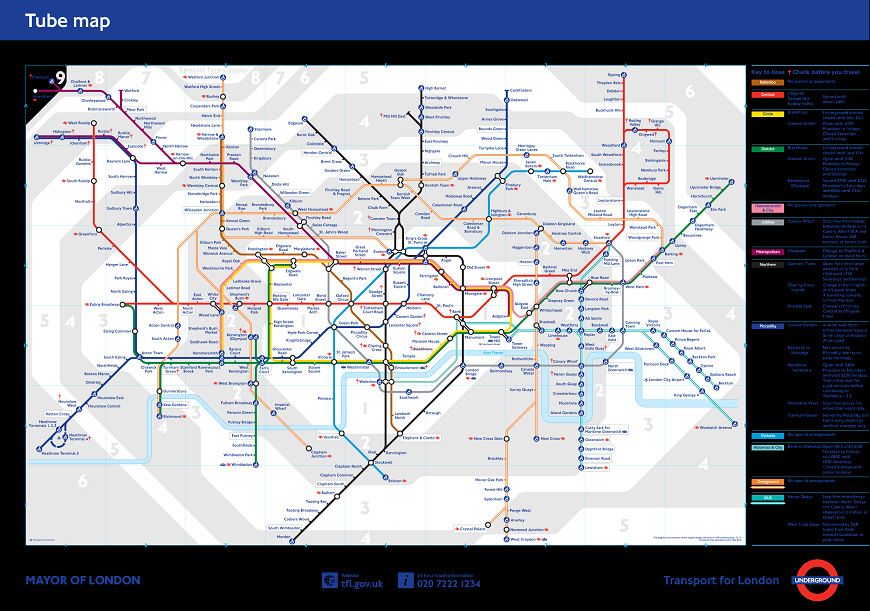 |
|
London Underground |
|
|
|
|
|
Putting Today into Context The origins of today’s Underground are a direct result of the chaos caused by road congestion as London continued to grow during the 18-19th Centuries. The original section of line was opened on 10 January 1863 by the then serving Prime Minister, William Gladstone, which served a route of less than 6 miles in length between Paddington (Bishop’s Road) and Farringdon and was constructed and run by the Metropolitan Railway. Much of the original route survives in use to this day. Rival companies such as the District Railway also constructed sub-surface routes and slowly, as each line opened, both the railway network and the London metropolis grew. In time the term ‘commuter belt’ was coined to represent the area around London that railways served allowing commuters to travel back and forth into the capital on a daily basis for work; a tribute to the efficient functionality of the railway as a transport system. By the 1920s, particularly in relation to bus routes, it was realised that a more centralised approach was needed with regard to the transport network that served the London metropolis. As an example buses hardly ever served more remote areas of suburbia, whereas in towns competing bus companies had started to use underhanded tactics such as blocking to steal passengers from one another. Acts of Parliament allowed London Transport to come into being on 1 July 1933, bringing the Underground network, trams and buses under one controlling public body. Almost immediately huge amounts of time, planning and investment were made to upgrade the Underground. New tube and sub-surface rolling stock were designed, ordered and introduced into passenger use within 5 years. The network also continued to reach further out North and East of London, as far as Barnet and Ongar, although the planned and partially completed extension north of Edgware to Elstree (often referred to as the ‘Northern Heights) was abandoned, with the advent of the Second World War playing a significant role in this decision. By the 1960-70s additional passenger demand resulted in two additional lines being constructed, the Victoria, the first section of which opened on 1 September 1968 and the Jubilee, originally referred to as the Fleet Line, that opened on 1 May 1979. The levels of investment and fares charged to passengers became a political football during the 1980s, which resulted in the abolition of the Greater London Council (GLC) and creation in 1985 of London Regional Transport (LRT) with London Underground Limited (LUL) as subsidiary company. In effect a new operational landscape had been created, with a private company running the Underground network, whist overall the system remained under state control. Like its predecessors, LUL had to improve cost efficiencies such as introducing one-man-operation on all Underground services, whilst continuing to increase capacity and renew life expired rolling stock on the Jubilee (95ts) and Northern (96ts) lines. However LRT also had to deal with darker issues such as an increasing focus upon passenger safety particularly following the fatal Kings Cross fire in November 1987. London Regional Transport ceased to exist in 2000, however in its 15 years it also witnessed the construction of the Docklands Light Railway (DLR) that played an enormous part in regenerating the Docklands area that had been extensively bombed during the Blitz and subsequently ignored. The Jubilee Line extension to Stratford that opened in 1999 also serves Docklands and helped to cement the success and financial hub that the area has become today. In 2000 Transport for London (TfL), under the control of the Greater London Authority (GLA), was created taking over from LRT with the sole purpose of implementing the Mayor of London’s transport strategy. From a railway perspective its remit covers London Underground, the Docklands Light Railway and since in was created in November 2007, London Overground. |
 |
|
About this section The concept of the Underground section is to give an insight into the complexities of running a railway, with the expressed aim of giving the visitor a better understanding of the Underground. The best way in which to give a flavour of how a line operates is to use one as an example, explaining the features of the line, the key operational aspects of operating a railway and how these elements fit together to keep a train service running. The line chosen to represent the Underground is predictably the... ... District ! Much has been written elsewhere, published in books or on the internet, regarding London Underground (e.g. Wikipedia or, as a typical example, in Christian Wolmar’s book, The Subterranean Railway). Consequently besides the historical review above, the same facts and figures published elsewhere will not be regurgitated here. Instead this refreshed District Dave London Underground site reuses much of the excellent material from Dave’s original Trainweb site and intends to build upon this further by responsibly giving an constant insight into life behind the LU Roundel. Responsibly, because understandably there will be issues of security and consequently certain aspects will not feature. Further useful information about current Underground service levels or future Underground upgrade plans can be found on the TfL.gov.uk website. Important: As mentioned already on the Homepage, its important to highlight that the views expressed on this website are solely those of the author(s) or contributor(s) and not necessarily those of, or endorsed by (nor is this site connected to) London Underground Ltd. or Transport for London. |
|||||
 |
|||||
|
Reproduced with kind permission of Transport for London © TfL |
|||||
 |
